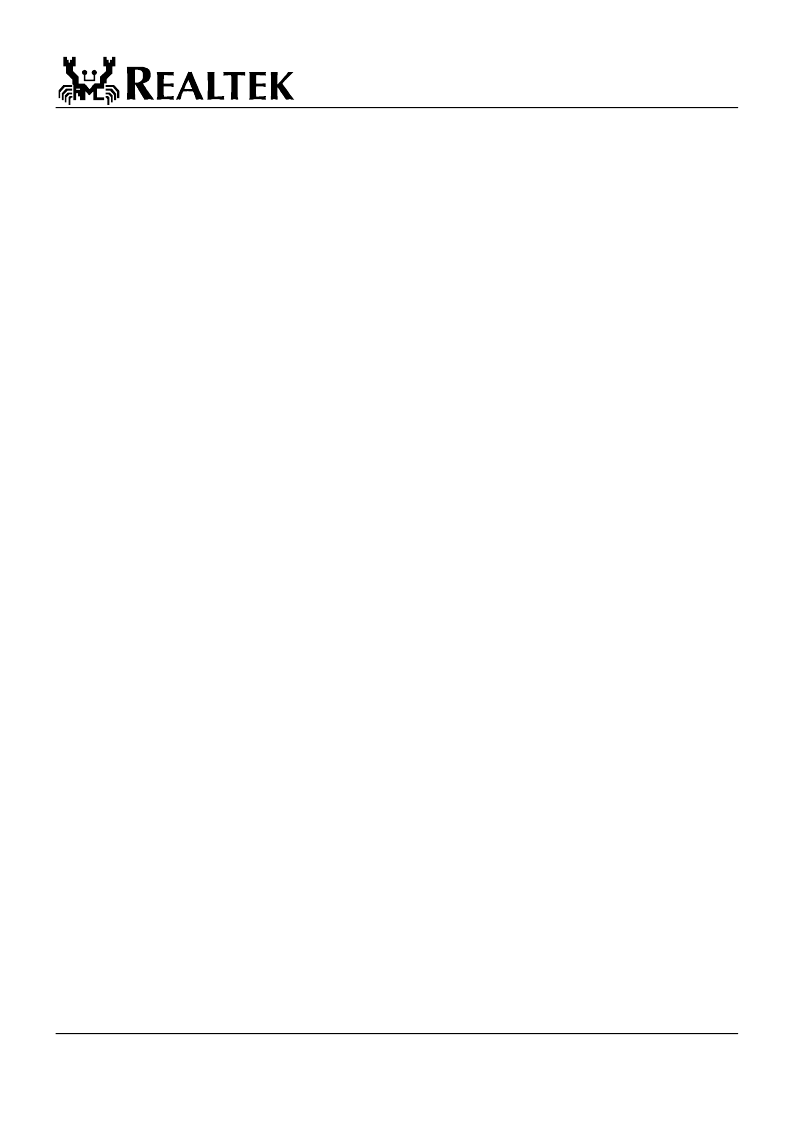- 您現(xiàn)在的位置:買賣IC網(wǎng) > PDF目錄373330 > RTL8305SB RTL8305SB PDF資料下載
參數(shù)資料
| 型號(hào): | RTL8305SB |
| 英文描述: | RTL8305SB |
| 中文描述: | RTL8305SB |
| 文件頁(yè)數(shù): | 3/66頁(yè) |
| 文件大小: | 963K |
| 代理商: | RTL8305SB |
第1頁(yè)第2頁(yè)當(dāng)前第3頁(yè)第4頁(yè)第5頁(yè)第6頁(yè)第7頁(yè)第8頁(yè)第9頁(yè)第10頁(yè)第11頁(yè)第12頁(yè)第13頁(yè)第14頁(yè)第15頁(yè)第16頁(yè)第17頁(yè)第18頁(yè)第19頁(yè)第20頁(yè)第21頁(yè)第22頁(yè)第23頁(yè)第24頁(yè)第25頁(yè)第26頁(yè)第27頁(yè)第28頁(yè)第29頁(yè)第30頁(yè)第31頁(yè)第32頁(yè)第33頁(yè)第34頁(yè)第35頁(yè)第36頁(yè)第37頁(yè)第38頁(yè)第39頁(yè)第40頁(yè)第41頁(yè)第42頁(yè)第43頁(yè)第44頁(yè)第45頁(yè)第46頁(yè)第47頁(yè)第48頁(yè)第49頁(yè)第50頁(yè)第51頁(yè)第52頁(yè)第53頁(yè)第54頁(yè)第55頁(yè)第56頁(yè)第57頁(yè)第58頁(yè)第59頁(yè)第60頁(yè)第61頁(yè)第62頁(yè)第63頁(yè)第64頁(yè)第65頁(yè)第66頁(yè)

2. General Description
RTL8305SB
2002/04/09
3
Rev.1.0
The RTL8305SB is a Fast Ethernet switch, which integrates memory, five MACs, and five physical layer transceivers for
10Base-T and 100Base-TX operation into a single chip. All ports support 100Base-FX, which share pins (TX+-/RX+-) with
UTP ports and need no SD+/- pins, a development using Realtek proprietary technology. Due to the lack of auto-negotiation in
100Base-FX applications, the RTL8305SB can be forced into half or full duplex mode and can enable or disable flow control
in fiber mode.
The five ports are separated into 3 groups (GroupX/GroupY/Port4) for flexible port configuration using strapping pins upon
reset. The SetGroup pin is used to select port members in GroupX and GroupY. While the port members is determined, you
can use mode selection pin (GxMode/Gymode/P4Mode[1:0]) to select operating interfaces such as 10/100Base-TX,
100Base-FX. Each group has 4 pins to select initial port status (ANEG/Force, 100/10, Full/Half, Enable/Disable Flow Control)
upon reset. Upon reset, in addition to using strapping pins, the RTL8305SB also can be configured with an EEPROM or
read/write operation by a CPU through the MDC/MDIO interface.
The fifth port (port 4) supports an external MAC interface, which can be set to PHY mode MII, PHY mode SNI, or MAC
mode MII to work with a routing engine, HomePNA or VDSL transceiver. In order to accomplish diagnostics in complex
network systems, the RTL8305SB also provides a loopback feature in each port for a variable CPU system.
The RTL8305SB contains a 1K entry address look-up table and supports a 16 entry CAM to avoid hash collisions and to
maintain forwarding performance. The RTL8305SB supports IEEE 802.3x full duplex flow control and back- pressure half
duplex flow control. The broadcast storm filtering function is provided to filter unusual broadcast storm issues and has an
intelligent switch engine to prevent Head-Of -Line blocking problems.
The RTL8305SB supports 5 groups of VLANs which can be configured with port based VLAN and/or 802.1Q tag VLAN.
ARP broadcast and Leaky VLAN are also supported for advanced applications.
The RTL8305SB supports several types of QoS functions with two level priority queues to improve multi-media or real-time
networking applications. The QoS functions are based on: 1) Port based priority; 2) 802.1Q VLAN priority tag; 3) The
TOS/DS (DiffServ) field of TCP/IP. In order to avoid the flow control function effecting the quality of high priority frames, the
RTL8305SB supports an intelligent flow control for high priority frames by setting DisFCAutoOff to automatically turn off
flow control for 1~2 seconds whenever the congestion port receives high priority frames. When the QoS function is enabled, a
VLAN tag can be inserted or removed at the output port. The RTL8305SB will insert a VLAN priority-tag (VID=0x000) for
untagged frames or remove the tag for all tagged frames.
Maximum packet length can be 1536 or 1552 bytes according to the initial configuration (strapping upon reset). The filtering
function is supported for the 802.1D specified reserved group MAC addresses (01-80-C2-00-00-03 to 01-80-C2-00-00-0F).
The RTL8305B provides flexible LED functions for diagnostics, which include: 1) Four combinations of link, activity, speed,
duplex and collision which are designed for convenient LED displays, such as bi-color LEDs; 2) Reset blinking; 3) Blinking
time selection. The RTL8305SB also provides a loop detection function and alarm, for network existence notification, with an
output pin which can be designed as a visual LED or a status input pin for a CPU.
The RTL8305SB implements a power saving mode on a per port basis. One port automatically enters power saving mode 10
seconds after the cable is disconnected from it. The RTL8305SB also implements a power down mode on a per port basis.
Users can set MII Reg.0.11 to force the corresponding port to enter the power down mode, which disables all transmit/receive
functions, except SMI (MDC/MDIO management interface).
Each physical layer channel of the RTL8305SB consists of a 4B5B encoder/decoder, a Manchester encoder/decoder, a
scrambler/descrambler, a transmit output driver, output wave shaping filters, a digital adaptive equalizer, a PLL circuit and a
DC restoration circuit for clock/data recovery. Friendly crossover auto detection and correction functions are also supported
for easy cable connection.
The integrated chip benefits from low power consumption, advanced functions with flexible configurations for 5-port SOHO
switch, Home Gateway, xDSL/Cable router, and other IA applications.
相關(guān)PDF資料 |
PDF描述 |
|---|---|
| RTL8316 | Specifications |
| RTL8801 | Specifications |
| RTM5070 | IR LEUCHTELEMENT ZUR FRONTPLATTENMONTAGE |
| RTP-PT100 | MESSFUEHLER PT100 EXTERN |
| RTR25 | "CLOCK 8""RIGHTIME - RADIO CONTROL" |
相關(guān)代理商/技術(shù)參數(shù) |
參數(shù)描述 |
|---|---|
| RTL8305SC | 制造商:未知廠家 制造商全稱:未知廠家 功能描述:用于100M網(wǎng)絡(luò)交換 |
| RTL8305SC-LF | 制造商:Realtek Semiconductor 功能描述: |
| RTL8308B | 制造商:Realtek Semiconductor 功能描述:8-PORT 10/100 ETHERNET SWITCH CONTROLLER WITH EMBEDDED MEMORY, PQFP128 |
| RTL8309SB | 制造商:未知廠家 制造商全稱:未知廠家 功能描述:SINGLE-CHIP 9-PORT 10/100MBPS SWITCH CONTROLLER |
| RTL8309SB-LF | 制造商:Realtek Semiconductor 功能描述:RTL8309 Series 9 Port 10/100 Mbps Ethernet Switch Controller - PQFP-128 制造商:Realtek 功能描述:RTL8309 Series 9 Port 10/100 Mbps Ethernet Switch Controller - PQFP-128 |
發(fā)布緊急采購(gòu),3分鐘左右您將得到回復(fù)。